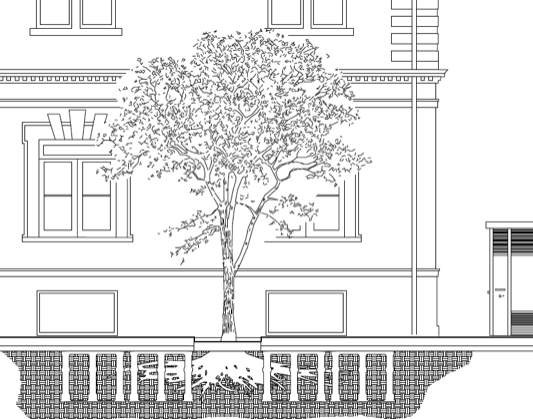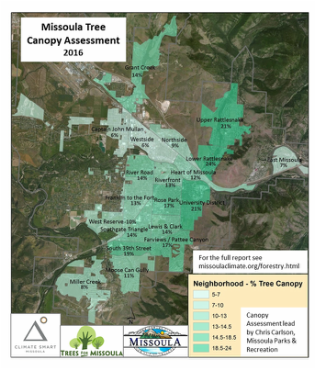|
The other day, I was talking to someone who recently moved to Missoula from the southwest. “There are so many trees here!” she exclaimed. Missoula does have a lot of trees - over 30,000 just on city-owned right of ways! - but that fact is no happy accident. The robustness of our urban forest is a result of dedicated folks in local government, community advocacy organizations, and regular citizens who are committed to keeping this cornerstone of our local ecosystem thriving. And it’s not just trees, either - it’s shrubs and grasses and native plants of all kinds in our urban and surrounding areas that contribute ecological diversity, habitat, and ecosystem services that support climate resiliency and community health. Urban forestry was the focus of October’s monthly meetup, and we were thrilled to be joined by Marie Anderson with the City of Missoula’s Urban Forestry division and Karen Sippy with Trees for Missoula. As always, the conversation was wide ranging and inspiring, but also raised plenty of questions and highlighted opportunities to do more on this issue. Trees as a climate solution Trees in particular have recently occupied headlines as researchers have attempted to calculate just how much potential they have to store carbon. We know there’s no silver bullet when it comes to climate action (if hunting season metaphors are your thing, climate solutions are more like silver buckshot). But it’s no wonder people are excited about trees: they have a whole host of benefits beyond taking CO2 out of the air. Here in Missoula, Climate Smart has partnered with the City and County over the last year and a half on a comprehensive Climate Resiliency Planning process, and it turns out that trees - and shrubs and green infrastructure - are so integral to building our community’s climate resilience that they are part of 8 out of 9 sectors represented in the plan (draft to be released this fall for community input - stay tuned!). Growing our urban forest and green infrastructure: education Whether on public land or private, how do we maintain the health of our urban forest given its importance to ensuring a climate-resilient Missoula? As with so many things, education is key. Some of the education that’s needed is at the citizen level: for example, Trees for Missoula has been working to ensure residents have all the information they need to care for new trees that have been planted on city boulevards, which are generally the responsibility of adjacent property owners - not everyone knows this! Even well-meaning folks with water conservation in mind don’t always know that watering trees and shrubs (and yes, even reasonably-sized lawns!) is okay here, because excess water generally makes its way through our porous valley soils and back into the resilient Missoula Aquifer under our feet. In fact, many of our street trees (there are over 116 species in our public urban forest!) require additional water beyond annual rainfall. Learn more about watering trees HERE. We can also improve education within our schools. Kids may learn about trees in biology class or understand how they take in CO2 and provide oxygen for us to breathe, but the practical tools to grow and care for trees are a gap that Trees for Missoula and the City Forestry department are working to fill with a new educational course for Big Sky High School’s agricultural cohort. This class has the potential to be replicated in other schools, so kids across our community are equipped to be tree stewards. Education is also needed within local government agencies tasked with supporting our urban green spaces and builders and developers. The good news is that this education is happening, and even within the last few years, there’s been a shift in how city departments consider green infrastructure, from planning to development to permitting, Missoula Water to Development Services and engineering. Going forward, it’s even more essential to integrate these kinds of climate resiliency considerations into development and redevelopment projects. Silva cells are an interesting example of this: a “suspended pavement system” that allows sidewalk trees to root much more deeply and thrive, Marie and Karen shared how this technology is now becoming the default for many of the redevelopment projects downtown, where more trees can help make pedestrian areas cooler and actually extend the lifetime of asphalt and pavement.
12 Comments
We were thrilled to be part of Sunday Streets Missoula yesterday! What could be a better way to celebrate community connections and promote healthy, active transportation? With Higgins Avenue closed to cars from 5th Street all the way to the XXXXs, Missoulians young and old came out to walk, bike, skate, scooter, and dance along the downtown corridor. Climate Smart Missoula was there to share tips on how to be Summer Smart, and provide a fun, refreshing cool-down with our DIY sprinkler! (Plenty of ideas out there for how to build your own - try Googling “DIY PVC kids sprinkler/mister”.) Check out some of our favorite photos below. We loved seeing kids and adults alike having fun with water. It’s an easy (and cheap) way to stay cool when the heat rolls in! As much as we know the importance of water conservation, using some water can be a good thing – not just for us, but for our trees, too. When it gets hot and dry out, it’s ok to neglect your lawn (brown is the new green!) but don’t forget to water your trees! They shade our homes and streets and help make our whole city cooler and healthier. Interested in continuing the conversation about water? Maybe you’ve tried to cool down by jumping in the river, and wondered about all the green algae. Join us for our next monthly meetup, Thursday, August 4th from 5-7pm at Imagine Nation Brewing Company. Folks from the Clark Fork Coalition will be on hand to chat about water quality and conservation in our changing climate. We provide snacks, INBC has delicious beer on tap - all are welcome! I had a special relationship with the giant sycamore tree in my front yard growing up. I would climb into the upper branches, reveling in how different everything on the ground looked from my perch high in the air. Or I’d spend hours in the nearly perfect seat formed where the main trunk split into two, reading a book or studying the spotted bark and pointed leaves. Do you have a similar story? As we get older, we don't often stop to think about the trees that populate our neighborhoods, parks and open spaces. We all know trees are important. They beautify our city, they keep us cool, they give us clean air to breathe. How can we keep our trees happy and healthy? On June 2nd, Climate Smart Missoula’s monthly meetup was all about trees. We were joined by Karen Sippy from the citizen advocacy group Trees for Missoula, Chris Carlson from the City of Missoula Parks and Recreation Dept, Juliet Slutzger from the National Wildlife Federation, and curious community members. Here’s what we learned:
Wondering what you can do to help keep our urban forest in tip top shape?
As we experience hotter, drier summers, caring for our trees and growing more shade will be increasingly important. Check out our Summer Smart program and our Urban and Wildland Forests bucket to learn more! |
AuthorsAbby Huseth Archives
July 2024
Categories
All
|




 RSS Feed
RSS Feed


